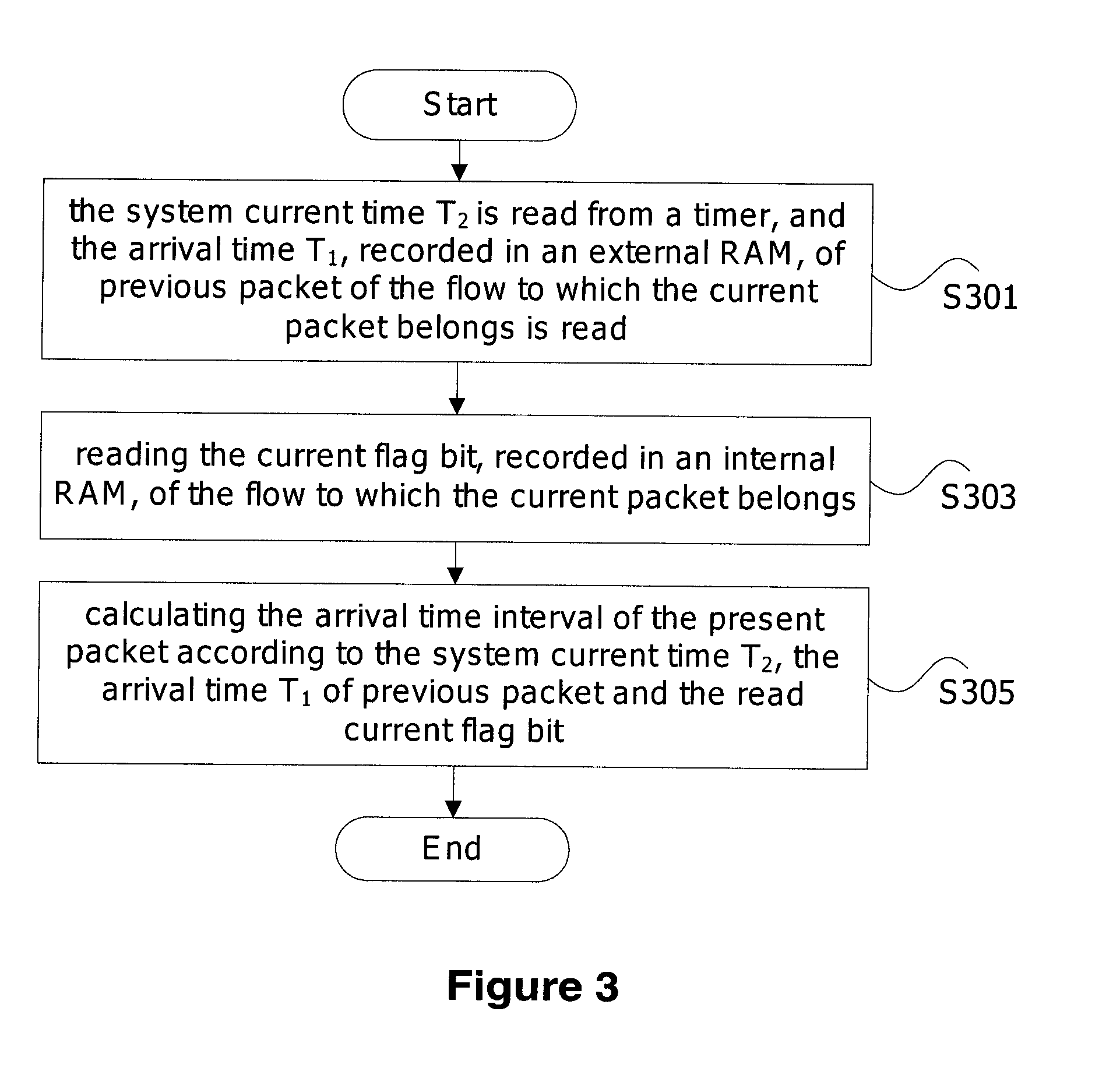Method and apparatus for calculating packet arrival time interval
a packet arrival time and packet technology, applied in the field of mobile communication, can solve the problems of data congestion, consuming a lot of operation resources, and failing to achieve the traffic policing effect, and achieve the effect of large storage spa
- Summary
- Abstract
- Description
- Claims
- Application Information
AI Technical Summary
Benefits of technology
Problems solved by technology
Method used
Image
Examples
embodiment i
[0049]This Embodiment is explained by means of the procedure of updating the flag bit recorded in the internal RAM and the arrival time of previous packet recorded in the external RAM when the current packet arrives.
[0050]FIG. 4 is the flowchart of this Embodiment. As shown in FIG. 4, the procedure of updating the flag bit recorded in the internal RAM and the arrival time of previous packet recorded in the external RAM when the current packet arrives mainly comprises the following steps.
[0051]Step S401, when the current packet arrives, the value of the current system timer is written into the external RAM with the serial number of the flow to which the packet belongs as the address.
[0052]Step S403, the flag bit of the internal dual-port RAM is set as 1 with the serial number of the flow to which the packet belongs as the address. In the above steps, the order of Step S401 or Step S403 is not limited. At this time, the packet arrival time updating ends.
embodiment ii
[0053]This Embodiment describes the procedure of scanning the flag bit of the arrival time of previous packet of each flow recorded in the internal RAM.
[0054]FIG. 5 is the flowchart of this Embodiment. As shown in FIG. 5, in this embodiment, the procedure of scanning and updating the flag bit of the arrival time of previous packet of each flow recorded in the internal RAM mainly comprises the following steps.
[0055]Step S501: after the flag bit scanning and updating procedure begins, it is judged whether the value of the system timer is 0, wherein if the judgment result is yes, Step S502 is performed, otherwise, the judgment is continued.
[0056]Step S502: when the counting value of the system timer is 0, a new round of flag bit scanning and updating is started up and the index number of the current scanned flow is cleared to 0.
[0057]Step S503: the flag bit of the current scanned flow is read with the index number of the current scanned flow as the address.
[0058]Step S504: if the read ...
embodiment iii
[0062]In this Embodiment, the procedure of calculating the arrival time interval of the present packet after the current packet arrives is described.
[0063]FIG. 6 is the flowchart of this Embodiment. As shown in FIG. 6, in this Embodiment, the procedure of calculating the arrival time interval of the present packet when the current packet arrives mainly comprises the following steps.
[0064]Step S601, recording the arrival time T2 of current packet; reading the external RAM to read out the arrival time T1 of previous packet of the flow to which the packet belongs; and reading the internal dual-port RAM to read out the current flag bit of the flow to which the packet belongs.
[0065]Step S602, judging the read flat bit, wherein if the flag bit is 2′b01 (namely ‘01’ occupies 2 bits), then the present packet arrival time interval at present time is (T2−T1); if the flag bit is 2′b10 and T2≧T1, the token bucket has overflowed and shall be filled up directly; if the flag bit is 2′b10 and T21, ...
PUM
 Login to View More
Login to View More Abstract
Description
Claims
Application Information
 Login to View More
Login to View More - R&D
- Intellectual Property
- Life Sciences
- Materials
- Tech Scout
- Unparalleled Data Quality
- Higher Quality Content
- 60% Fewer Hallucinations
Browse by: Latest US Patents, China's latest patents, Technical Efficacy Thesaurus, Application Domain, Technology Topic, Popular Technical Reports.
© 2025 PatSnap. All rights reserved.Legal|Privacy policy|Modern Slavery Act Transparency Statement|Sitemap|About US| Contact US: help@patsnap.com



